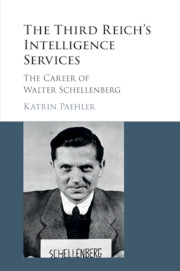Book contents
- Frontmatter
- Dedication
- Contents
- List of Figures
- Acknowledgments
- Archives
- Introduction
- 1 Gaining a Foothold
- 2 Rising Star
- 3 Intelligence Man
- 4 Office VI and Its Forerunner
- 5 Competing Visions: Office VI and the Abwehr
- 6 Doing Intelligence: Italy as an Example
- 7 Alternative Universes: Office VI and the Auswärtige Amt
- 8 Schellenberg, Himmler, and the Quest for “Peace”
- 9 Postwar
- 10 Concluding Thoughts
- Appendix
- Glossary
- Index
8 - Schellenberg, Himmler, and the Quest for “Peace”
Published online by Cambridge University Press: 31 March 2017
- Frontmatter
- Dedication
- Contents
- List of Figures
- Acknowledgments
- Archives
- Introduction
- 1 Gaining a Foothold
- 2 Rising Star
- 3 Intelligence Man
- 4 Office VI and Its Forerunner
- 5 Competing Visions: Office VI and the Abwehr
- 6 Doing Intelligence: Italy as an Example
- 7 Alternative Universes: Office VI and the Auswärtige Amt
- 8 Schellenberg, Himmler, and the Quest for “Peace”
- 9 Postwar
- 10 Concluding Thoughts
- Appendix
- Glossary
- Index
Summary
I mentioned back then among my friends that only praetorians were in the habit of toppling the Caesars.
Dr. Giselher Wirsing Affidavit, December 29, 1949Walter Schellenberg wanted to be the man who ended the war. He claimed time and again that he broached the idea of peace negotiations with Himmler as early as August 1942 and made several attempts to contact the West, only to be held back by Himmler at the last moment. It was not until the last months of the war that Himmler agreed to pursue careful peace soundings that later morphed into similarly conditional surrender offers; Schellenberg served as his emissary. To establish and maintain contacts with the West, Schellenberg displayed a willingness to possibly release even large groups of Jewish and Gentile prisoners. This was Schellenberg's and Himmler's alternative foreign policy at its height. Ultimately, he failed to deliver but succeeded in saving his own skin. War's end found Schellenberg in Sweden, living under the protection of Count Folke Bernadotte, a member of the royal family, the vice president of the Swedish Red Cross, and Schellenberg's partner in the last set of negotiations.
There are two uncontested facts. First, beginning in late 1944, Schellenberg began humanitarian negotiations with representatives of Switzerland and Sweden, respectively. Over the course of these activities, over 20,000 concentration camp inmates – including many Jews – were released. Secondly, in late April 1945, Himmler, after much prodding and cajoling by Schellenberg and via Swedish intermediaries who had initially come to Germany to negotiate for the release of prisoners, offered conditional surrender to General Dwight Eisenhower. Beyond this, much remains a matter of debate. What did Schellenberg want to achieve with his various initiatives and how much agency did he have? Is Schellenberg's claim that he wanted to bring about peace with the West as early as summer 1942 – when Germany was close to the height of its power – and worked tirelessly and relentlessly toward this goal only to be thwarted by Kaltenbrunner, Himmler, and others to be believed? Is his self-portrayal as an altruistic humanitarian, willing and eager to negotiate for the freedom of Jews and other victims of Germany without expecting much in return, truthful?
- Type
- Chapter
- Information
- The Third Reich's Intelligence ServicesThe Career of Walter Schellenberg, pp. 268 - 316Publisher: Cambridge University PressPrint publication year: 2017

